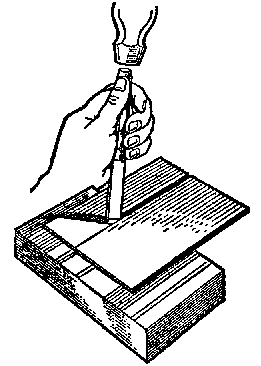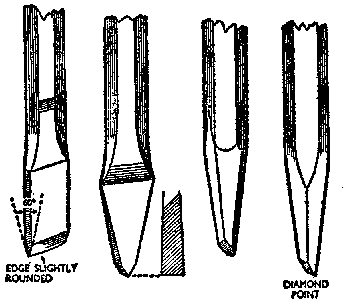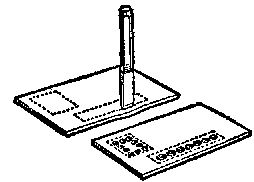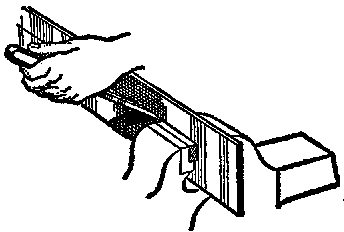
Cold chisels are used to cut heavy metal that cannot be cut with a saw or shears, usually because space is limited. They are also used for any number of repair jobs, such as cutting off rivet heads or slicing through rusted nuts and bolts, and other heavy work.
Before machine tools became available, cold chisels were more widely used in general engineering. Metal components were often made as close to the final size as possible by casting, so that most of the work in shaping the metal was done by the furnace. Cold chisels were then used to cut away material from the areas of the casting that needed to be brought to an exact size. These areas were then finished by filing and scraping.
Cold chisels are made from carbon tool-steel, which is usually octagonal in cross-section. Tool-steel is used as it can be hardened to form a hard and tough cutting edge.
To make a cold chisel heat the end of the bar of tool steel until it is bright red and hammer to the desired shape. You will need to reheat the bar several times as it cools quite quickly when you hammer it. If you don't have a blacksmith's anvil you can use the face of a large sledge hammer instead (if the face is not too scarred). Clamp the sledge hammer in a large vice to keep it steady. Don't strike to face of the sledge hammer with your forging hammer or you may knock off chips of hardened steel which can damage your eyes.
Once the end of the bar has been hammered to the right shape you can grind the cutting edge as shown in the diagram. Harden the bar and then temper it to make the edge tough so that it does not crack. Different materials will require slightly different edge grinding and tempering.
Types of Chisels[edit | edit source]
Figure 2 shows the four kinds of chisels that are in common use.
- The flat chisel is the most widely used and has a place in every workshop and tool kit. It has a broad cutting edge which should be slightly rounded so that the corners do not dig into the metal. This chisel can be used for cutting off rods, cutting out sheet metal, and other jobs of this sort. In the days before machine-made files, a worker would use a special wide and short flat chisel to cut the teeth in a file before it was hardened.
- The crosscut or cape chisel is forged so that the cutting edge is slightly wider than the body; this is to ensure that the chisel does not bind in the cut when it is used for deep grooves. As well as cutting single grooves, the crosscut chisel is used to cut a grid pattern of grooves when a lot of material must be cut away from a surface. After the grid pattern has been cut you can use the flat chisel to chip off the remaining square pieces.
- A round-nose or half-round chisel is used for special work, such as forming flutes and channels. You can cut the oilways on the inside surface of a bearing bush using a round nosed chisel.
- The diamond-pointed chisel is drawn down to a square section at the end and then ground away to a single bevel. It is used for chipping through plates and cleaning out square internal angles. A tool very similar to the diamond-point chisel is used to cut the teeth on a wood rasp.

How to Use a Cold Chisel[edit | edit source]
Cutting Sheet Metal[edit | edit source]
When used to cut sheet metal, the chisel must be held at a slight angle to the surface of the metal as shown in Figure 1. This is done so that when the chisel is struck by the hammer it moves along in a continuous line toward the worker as it cuts through the metal. If the chisel is held vertically, a separate cut is made each time the chisel is struck by the hammer, and the "line" then becomes a series of short cuts. A block of soft iron is generally used for support.
Chiseling Sheet Metal
[edit | edit source]

The method used to cut slots of various shapes and sizes out of a a sheet of metal is similar to that for cutting a straight line. However,the removal of the unwanted metal can be simplified by drilling a series of holes as close together as possible along the outline of the slot before using the chisel. This must always be done when cutting out a slot close to the edge of a sheet (cp. Figure 3); otherwise, the chisel will distort the shape of the plate.
When cutting metal held in a vise (cp. Figure 4), care must be taken so that the line to be cut is as close to the top of the bench vise as possible, so that the metal is not accidentally bent or the edge of the cut badly burred.

Sharpening[edit | edit source]
All of the chisels described are usually sharpened by grinding, preferably on a wet grindstone. After frequent regrinding, however, the cutting edge becomes too thick. In this case the chisel has to be heated, drawn down to shape, and retempered. The desired thickness of the edge will vary according to the kind of metal that is to be cut; the softer the metal, the thinner the edge of the chisel.